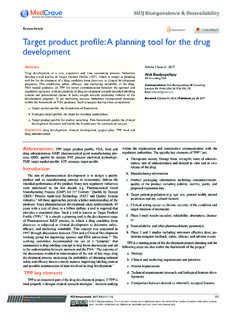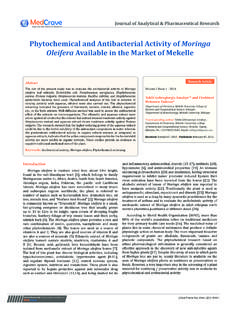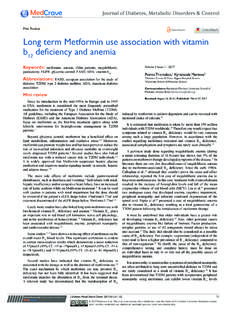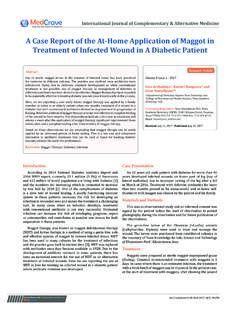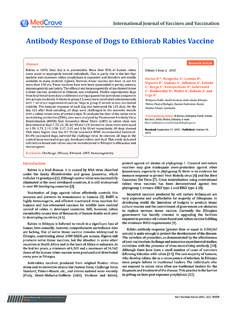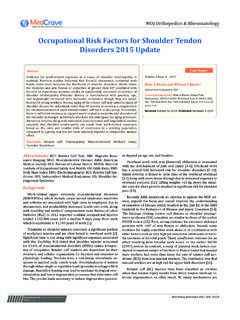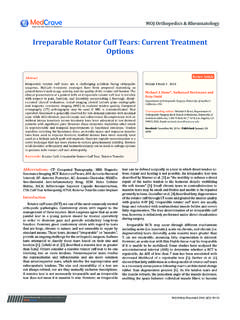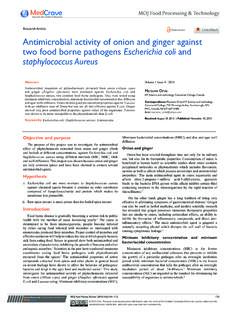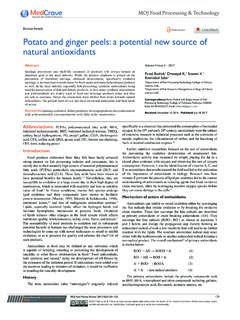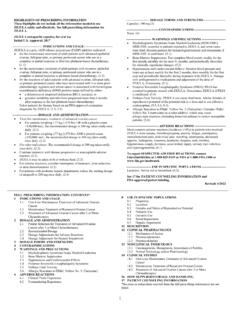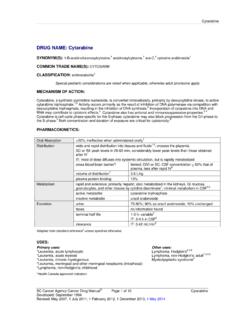Transcription of Hematological changes in pregnancy – the preparation for ...
1 Obstetrics & Gynecology International Journal Hematological changes in pregnancy - The preparation for intrapartum blood LossSubmit Manuscript | is associated with various physiological changes , which tend to affect most of the body system and some of these begin immediately after conception continuing through delivery to the postpartum period in order to accommodate both the maternal and fetal hematologic system adapts to make provision for fetal hematopoiesis, ensuring adequate blood supply to the enlarged uterus and its content thereby protecting both mother and fetus against the effects of impaired venous return in both the supine and erect positions in addition to safeguarding against bleeding at delivery.
2 The maternal blood volume at term is about 50% above the non pregnant level in normal pregnant women, averaging about 100ml/kg and the presence of a fetus is not needed for the Hematological changes as an increase in blood volume have been seen in women with hydratidiform mole [1,2]. Major Hematological changes seen can be broadly categorized under:1) Physiologic Anemia2) Leukocyte and Immunological function 3) Mild Thrombocytopenia4) Coagulation and fibrinolysisPhysiologic Anemia This is also referred to as dilutional anemia and it results from an increased plasma volume to red blood cell ratio. It is detected between the late second and third trimester with peak at 30-34weeks GA [3].Its absence has been associated with an increased tendency for stillbirths while its presence conveys benefits related to decreased blood viscosity and reduced resistances to blood flow culminating in increased perfusion of the placenta [4].
3 Maternal hemoglobin level tends to increase by the third day postpartum and there is a diuresis-induced resolution of pregnancy -induced anemia by the 6th week average hemoglobin level is about at term and according to the World Health Organization (WHO), anemia is hemoglobin level less than 11g/dl. It is classified as severe, when less than 7g/dl and hemoglobin level less than 4g/dl is very severe necessitating urgent treatment to prevent the development of congestive heart failure [5]. The United States Center for Disease Control (CDC) denotes anemia as hemoglobin less than in the 2nd trimester and less than 11g/dl in the 1st and 3rd trimesters [6].The frequent use of iron supplementation in pregnancy has been associated with a reduction in maternal anemia at delivery and only about 6% of pregnant women on Iron supplementation should present with a hemoglobin level less than 11 g/dl [7].
4 The postpartum hematocrit is usually similar to the prelabor hematocrit by the 7th day postpartum in the absence of excess blood loss or disease states such as preeclampsia [8].Plasma volume changesThe total plasma volume at term is 4700-5200mls due to a gain of about 1100-1600mls and an average of 10-15% increase in plasma volume by 6-12 weeks gestation with a progressive rapid rise till the 34th week [1,9]. The result is a plasma volume that is about 30-50% above that of the non-pregnant, which later regresses to about 10-15% above that of the non-pregnant by the 3rd week postpartum and is at normal non-pregnant level by the 6th week. Volume 4 Issue 3 - 2016 Department of Obstetrics and Gynecology, USA*Corresponding author: Olukayode Akinlaja, Assistant Professor, Department of Obstetrics and Gynecology, University of Tennessee College of Medicine, Chattanooga, Tennessee, USA, Tel: 423-778-2580; Email: Received: December 14, 2015 | Published: March 31, 2016 Review ArticleObstet Gynecol Int J 2016, 4(3): 00109 AbstractThe hematologic system undergoes a series of adaptive changes in preparation for fetal hematopoiesis and wellbeing while also serving as a cushion against expected blood loss at delivery.
5 These changes range from the increased plasma volume and red blood cell mass, leucocytosis and adaptive immunological changes to the relative hypercoagulable state of pregnancy and tend to commence as early as the 6th week of gestation with resolution by the 6th week : Hematological changes ; pregnancy ; Prevention; intrapartum blood loss ; Hypercoagulable state; PostpartumHematological changes in pregnancy - The preparation for intrapartum blood Loss2/5 Copyright: 2016 AkinlajaCitation: Akinlaja O (2016) Hematological changes in pregnancy - The preparation for intrapartum blood loss . Obstet Gynecol Int J 4(3): 00109. DOI: reasons that have been espoused for the increased plasma volume include a response to the under-filled vascular system resulting from systemic vasodilatation, reduced systemic vascular resistance and blood pressure as well as increased cardiac output associated with sodium and water retention.
6 Red blood cell changesThe erythrocyte volume is about 250-450mls higher at term in women on iron supplements compared to those not supplemented and about 20-30% higher than that in the non-pregnant state [1]. A 15-20% increase in red blood cell mass is seen in non-iron supplemented pregnant women bearing in mind that 1ml of red blood cell mass has about of elemental iron [10].A progressive increase occurs from 8-10 weeks gestation till the end of pregnancy but the average red blood cell life span is slightly reduced [1]. The average mean corpuscular volume is about 4 fl higher in healthy pregnant women but decreases to an average of 80-84 fl in those not on Iron supplements [11].Erythropoietin levels are 50% higher due to the higher metabolic oxygen requirement and this accounts for the moderate bone marrow erythroid hyperplasia and elevated reticulocyte count.
7 There is also an increased transportation of oxygen across the placenta due to the combination of a reduced maternal RBCs oxygen affinity from an elevated 2,3 Diphosphoglycerate and a low maternal pCO2 [12].Physiologic effects of hypervolemia and anemiaA reduced resistance to flow from the decreased blood viscosity results in an increased placental perfusion and reduced cardiac work. The increase in total blood volume at term, which averages about 47% (+/- 15) above the non-pregnant serves as a reserve against normal blood loss at delivery and peripartum hemorrhage [13]. blood loss at delivery range from 500mls at normal singleton vaginal delivery, 1000mls at twin delivery and cesarean section to 1500mls at cesarean hysterectomy [1].
8 The increased cardiac output to the placenta leads to an increased supply of nutrients to the fetus and those to the kidney and skin encourages excretion of maternal and fetal waste products and control of maternal temperature while a reduction in large cerebral blood flow has also been reported [14]. A lack of the hypervolemic changes and physiologic hemodilution has been shown to be associated with an increased risk of stillbirths especially small for gestational age associated stillbirths [4]. pregnancy RequirementsThe normal total body iron content in a non-pregnant woman is about 2g, which is about half that of men while the iron stores are only about 300mg [15].Iron supplementation is needed for the replacement of the approximately 1000mg needed during pregnancy , about 500mg of which is expended in the development of the maternal red blood cell mass, while the fetus and placenta utilize about 300mg.
9 Approximately 200mg of iron is excreted via the skin, urine and gastrointestinal tract. It is absorbed in the duodenum in the ferrous form and about 30mg of daily elemental Fe is needed as prophylaxis and more may be required depending on the degree of maternal anemia. An average of 3-4mg of iron needs to be absorbed per day during pregnancy although this is non-uniform as about 6-7mg is needed daily in the late second to third trimester [16]. Iron supplementation is usually given as 325mg of oral tablets, in the form of ferrous sulfate with 65mg of elemental iron, ferrous gluconate with 35mg and ferrous fumarate with 107mg of elemental Iron. In addition 400-800mcg of Folic acid is recommended daily during pregnancy for the increased red blood cell production while about 50-100mcg is needed Severe Anemia and ConsequencesPossible sequelae of inadequate Iron stores and folate deficiency derived from reduced intake and chronic hemolytic states, such as malaria and sickle cell disease are as listed in box 1 while box 2 encompasses standard laboratory 1A.
10 Spontaneous abortionB. Low birth weight infantsC. PrematurityD. Reduced amniotic fluid volumeE. Fetal cerebral vasodilationF. Non Reassuring Fetal heart tracingG. Increased neonatal mortality andH. Increased maternal mortalityBox 2 Standard laboratory Evaluationa) Complete blood countb) Reticulocyte countc) Peripheral smear reviewd) Serum Iron levele) Total Iron-binding capacityf ) Serum Ferritin level andg) Hemoglobin electrophoresis, if applicableIn areas where iron deficiency is prevalent, offsprings have demonstrated a positive correlation between prenatal iron/folic acid supplementation and intellectual functioning but fetal red blood cell production is not impaired even in the presence of severe maternal iron deficiency anemia [17,18].
